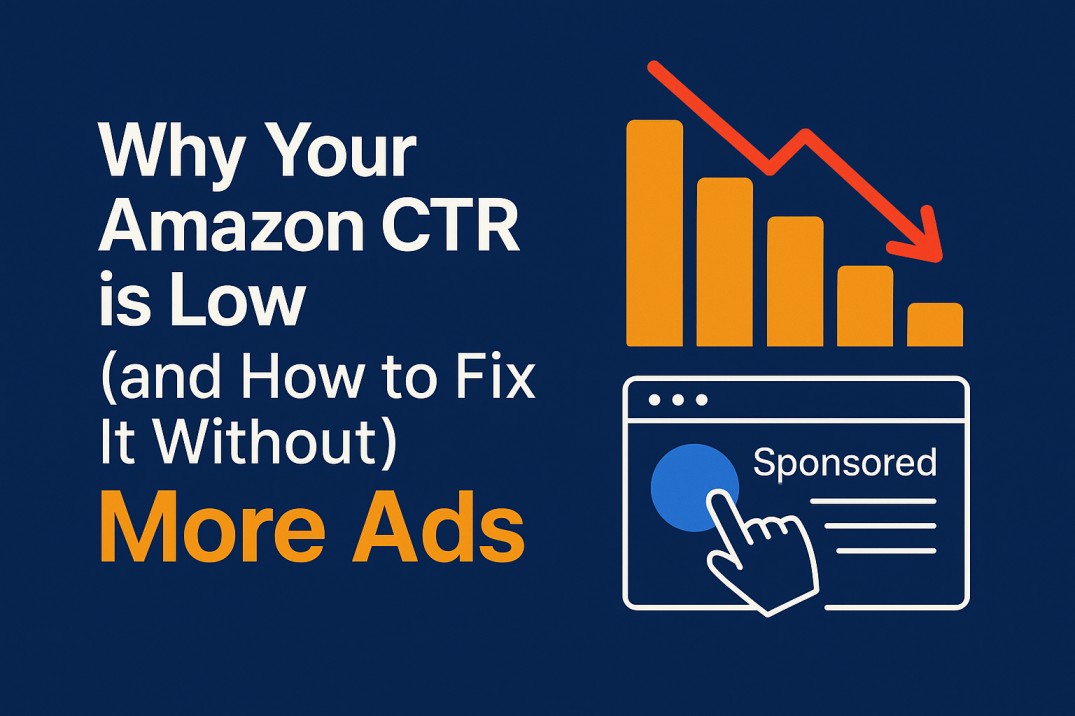Why Your Amazon CTR is Low (and How to Fix It Without More Ads)
Amazon sellers often chase more ad spend to boost visibility, but most overlook a simpler, cheaper lever: Click-Through Rate (CTR). Your listing could be ranking decently and still underperform simply because people aren’t clicking.
This article breaks down:
- What CTR really means on Amazon
- Why it matters more in 2025 than ever
- The exact reasons your CTR may be low
- What to fix—without spending more on ads
Let’s get straight into it.
What is Amazon CTR?
CTR (Click-Through Rate) on Amazon is the percentage of people who see your product in search results and actually click on it.
Formula:
CTR = (Number of Clicks / Number of Impressions) × 100
If 1,000 people see your listing and 25 click, your CTR is 2.5%.
In 2025, the average CTR across categories is between 0.35% to 0.75% depending on the niche and product type. Top-performing listings often exceed 1%.
Why CTR Matters (a Lot) in 2025
CTR is no longer just a nice-to-have metric. Amazon uses CTR as a core signal of relevance and desirability.
Here’s what CTR influences:
- Organic rankings (low CTR = downranking)
- Ad performance and cost (low CTR = high CPC)
- Inventory turnover
- Profit margins (due to wasted impressions)
If your CTR is low, your entire funnel suffers.
Common Reasons Why Your CTR is Low
Let’s look at the most frequent issues. These aren’t assumptions—they come from audit data across thousands of listings.
1. Weak or Generic Main Image
- Cluttered background
- Poor lighting or angles
- No clear benefit shown visually
- Irrelevant props
Your main image should be crystal clear, well-lit, and instantly recognizable. For certain categories, adding context (e.g., scale, color variation) improves CTR.
2. Boring or Confusing Title
- Keyword-stuffed titles that don’t make sense
- Missing primary benefit or use case
- No urgency or differentiator
CTR drops when the title doesn’t give a reason to click. A clear promise beats a long list of attributes.
3. Bad Star Rating or Too Few Reviews
- Anything below 4.2 stars kills CTR
- Fewer than 30–50 reviews shows lack of credibility
Buyers compare multiple options at once. If yours looks riskier, it gets skipped.
4. Irrelevant or Misleading Price Point
- Price doesn’t match perceived value from title/image
- Drastic price jumps vs. competitors nearby
Too cheap = “maybe low quality” Too expensive = “not worth it”
Both hurt CTR.
5. Category Misalignment or Wrong Thumbnail
- Appearing in irrelevant searches
- Thumbnail doesn’t match the product type buyers expect
This makes your listing invisible even when it’s visible.
6. A+ Content Isn’t Pulling Its Weight
While A+ Content is below the fold, it impacts CTR through:
- Mobile preview (thumbnail shows a portion)
- Brand perception (“serious” vs. “cheap”)
If A+ is sloppy, buyers bounce early.
What You Should Fix First (High-Impact, No-Ads Fixes)
Here’s where to focus first. These tactics improve CTR without increasing your ad spend.
1. Redesign Your Main Image for Mobile
- Use whitespace effectively
- Zoom in on product
- Use correct dimensions (2000px+ for zoom)
- Consider a subtle outline to pop on white background
A/B test using Amazon’s “Manage Your Experiments” if you’re brand-registered.
2. Rewrite Your Title for Humans
Structure it to answer: What is this and why should I care?
Template: [Primary Benefit] – [Product Type + Size/Count] – [Key Differentiator or Use Case]
Example: “24-Hour Cold – 32oz Insulated Water Bottle – Leak-Proof & Travel Friendly”
Use your most competitive keyword near the start, but don’t over-optimize.
3. Fix Your Star Rating With Review Mining
If your average is below 4.3, look into why.
Use tools like SellerMax to:
- Identify repeated complaints
- Spot potential quality or packaging issues
- Fix them and relaunch variations if needed
Also, engage Amazon Vine or automated review requests to build volume.
4. Align Price With Perceived Value
Check pricing next to competitors in the same row of search results.
Use SellerMax to:
- Track price vs. CTR movements
- Compare how competitors price similar products
- Spot elasticity points
If your price seems off, adjust or justify it in bullets/images.
5. Update Thumbnail Preview From A+ Content
Make sure the first module in your A+ layout is visual and helpful. That’s the one that shows in thumbnail previews.
Use visuals like:
- Comparison charts
- Lifestyle image + overlay benefit text
- Feature callouts
Don’t waste this slot on a brand logo.
6. Refine Your First Bullet Point
Amazon now shows the first bullet on some mobile search previews.
Make it:
- Short (under 200 characters)
- Benefit-led
- Outcome-focused
Example: “Keeps drinks ice cold for 24 hours – perfect for long shifts, travel, or gym.”
This drives curiosity and encourages clicks.
Bonus: Use AI Tools to Find What Buyers Actually Click
SellerMax.ai helps uncover:
- Which titles in your category get highest CTR
- What phrases buyers respond to
- How your images compare in heatmap testing
You get data-backed suggestions instead of just best practices.
Use AI to:
- Mine competitor listings for CTR winners
- Rewrite titles/bullets for real customer phrasing
- Optimize A+ based on buyer language clusters
Final Word: CTR is a Fixable Metric
You don’t need to throw more budget into Amazon ads if your CTR is the issue. Fix your listing first.
CTR is where first impressions are made. Get this right and every ad, every rank, and every search result view becomes more valuable.
Fix your amazon listing before you fund your ads.
Want help diagnosing your CTR issues? Run a free SellerMax audit and see what’s holding your listing back.
